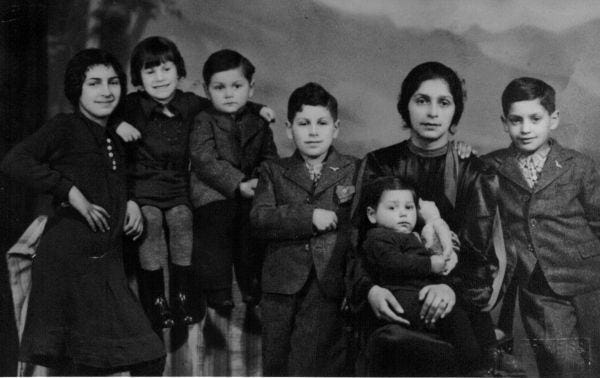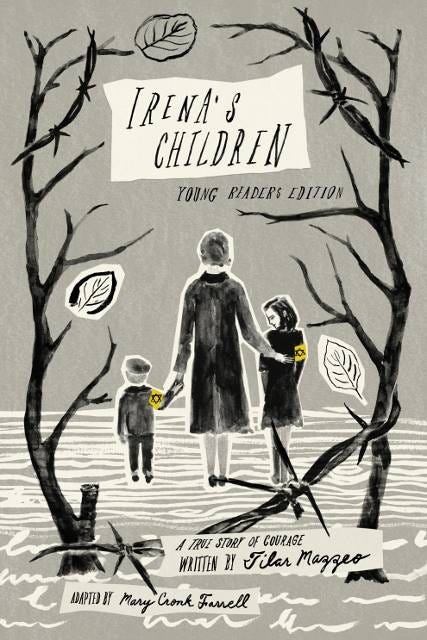I know you don’t want to hear terrible things this morning. So, the thing to focus on in this story is the incredible courage of women trying to protect their children and the power you have to make a difference.
With survey results showing 23% of American adults 18-39, believe the Holocaust was a myth, had been exaggerated or they weren’t sure, I must continue to share lesser-known stories like this one about Nazi genocide against the Romani people.
The Nazis murdered about 1.5 million out of an estimated 2 million European Roma during World War 11 according to Romani Scholar Ian Hancock. This is known in the Romani language as the Porajmos, or the Devouring.
Daniela Abraham, whose grandfather survived the Holocaust as a young teen because the SS officers enjoyed hearing him play his violin, wants the Roma who died to be remembered.
“A majority of the Roma never even made it to the camps, they were simply murdered whenever they were found, and their deaths went unrecorded,” she told TIME. “This is why there is such a major discrepancy between ‘official’ death tolls based upon Nazi records and the actual losses to our population.”
Roma life in Germany before 1942, where families traditionally lived a nomadic, itinerant lifestyle. [https://www.mdig.com.br/index.php?itemid=25212]
The Romani people, often called by the derogatory name “gypsies,” have a rich history across Europe after arriving in waves from the Indian subcontinent about the 13th to 14th century. The community, including numerous tribes of different names, are properly rereferred to as Roma, from the Romanes language in which Rom means man and Romni means woman.
Nazi SS chief Heinrich Himmler called for the “Final Solution of the Gypsy Question” ordering, on December 16th, 1942, that all Romani in Europe be deported to Auschwitz.
“It was the wish of the all-powerful Reichsführer Adolf Hitler to have the Gypsies disappear from the face of the earth,” according to SS Officer Percy Broad, Auschwitz Political Division.
Deportation of Sinti and Roma, Asperg, Germany, May 22, 1940. [German Federal Archives]
Records show Roma from Germany, Austria, Czechoslovakia, Poland, France, Holland, Belgium, Hungary, Yugoslavia, the USSR, Norway and Spain were transported to Auschwitz-Birkenau. Else Baker was eight years old, one of the few Roma to survive.
“I also [hold] in my memory the night when the sky above the crematorium was quite red and you could hear the cries of many people calling: ‘Murderers! Murderers!’ We all had to remain in the barracks, no one was allowed to go out into the street,” Else says, “I did not understand why…. I was told they were burning people. I remember exactly what I said: ‘But you cannot burn people. You burn wood or coal, but not people.’ For me this was quite incomprehensible.”
By spring 1944, the Roma in the concentration camp were well aware of the end the faced. But they grasped a tiny hope that they might survive.
The first attempt to liquidate the so-called "Gypsy Camp" where 6,500 Roma were imprisoned at Auschwitz-Birkenau came on May 16, 1944. That evening, 50-60 SS arrived at the camp gate and ordered the prisoners out.
Inside, the prisoners had barricaded the doors and desperately prepared to defend themselves with knives, shovels and stones.
Romani Holocaust survivor Hugo Höllenreiner testified later, "Dad shouted out – the whole building trembled when he shouted: ‘We’re not coming out! You come in here! We’re waiting here! If you want something, you have to come inside!’ "
Hugo Höllenreiner, on the far right, shown with his mother and five siblings. The family, including his father survived the Porajmos.
In the months that followed, the Nazis transported more than 1,000 Roma they considered able to work to Buchenwald and Ravensbrück. They planned to exterminate the final group of Roma in the camp the night of August 2, 1944, including 3,000 to 4,000 old men, women and children.
A young gypsy girl upon her arrival at Auschwitz-Birkenau, October 10, 1943. [Auschwitz-Birkenau State Museum Archives]
A former prisoner Alfred Fiderkiewicz described what he witnessed in the Zigeunerlager, or Roma family camp at Birkenau, as reported in the magazine MEMORIA published by the Auschwitz-Birkenau State Museum.
The date May 16 has been named Romani Resistance Day and is marked by many people around the world, a remembrance of courage in the face of evil.
Eighty years later, intolerance, hate speech and violence against Romani people continues in Germany and is on the rise in varying degrees in a number of European countries including Hungary, Serbia, Croatia, Italy, France and Bulgaria.
“We’re blamed for everything because everybody hates us,” Miroslav Angelo told the Guardian for a story about anti-Roma feeling in Bulgaria. More and more, we hear explicit hate speech in the media and from politicians and see brutality against my people from police and individuals. My country is becoming increasingly, and unashamedly more racist.”
In a recent Harvard University study in the US, close to 80% of the interviewees agree (38%) or strongly agree (40%) that Americans discriminate against people of Roma heritage. Women were more likely than men to hide their Romani, many feeling discriminated against in restaurants, stores, and similar service situations.
Discovering information like this disheartens me. Taking an action, no matter how small, can counteract feelings of powerlessness.
I learned that Holocaust education is only currently mandated in 25 states in America. Florida’s state education department rejected two new Holocaust-focused textbooks for classroom use, while forcing at least one other textbook to alter a passage about the Hebrew Bible in order to meet state approval.
What can we do?
Quick and easy: Donate to the United States Holocaust Museum.
A bit more time and energy? I've decided to donate a book about the Holocaust to a teacher you know or a local elementary school. If you'd like to do the same, here are some I recommend. I added mine to the list and I highly recommend it.
-We Must Not Forget: Holocaust Stories of Survival and Resistance by Deborah Hopkinson
-Signs of Survival: A Memoir of the Holocaust by Renee Hartman and Joshua M. Greene
-Hana's Suitcase: The Quest to Solve a Holocaust Mystery by Karen Levine
-Run and Hide: How Jewish Youth Escaped the Holocaust by Don Brown
-Irena's Children: Young Readers Edition; A True Story of Courage by Tilar J. Mazzeo, adapted by Mary Cronk Farrell 😊 ❤️
Want to really make a difference? Talk to your friends and neighbors about this issue. Email your local school district and find out if information about the Holocaust is part of the curriculum. Whatever the answer, share it on social media. If the answer is no, ask for it to be included. Consider getting a few people together and attending a school board meeting to bring attention to this issue.
Tell me what action you take!










